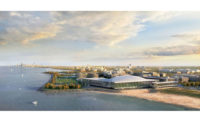Best of the Best
Project of the Year Finalist, Government/Public Building - National Bio and Agro-Defense Facility (NBAF)

The NABF federal campus has 715,000 sq ft of facility space, including a 574,000-sq-ft main laboratory building.
Photos courtesy of USDA NBAF Communications
National Bio and Agro-defense Facility
Manhattan, Kan.
Project of the Year Finalist
Submitted by: McCarthy Building Cos.
Region: ENR Midwest
Owner: U.S. Dept. of Homeland Security, Science & Technology Directorate
Lead Design Firm: NBAF Design Partnership JV, a Partnership of Perkins&Will, Flad Architects, Affiliated Engineers Inc., WSP and Merrick & Co.
General Contractor: McCarthy Mortenson JV, a partnership of McCarthy Building Cos. and Mortenson
MEP Engineer: Affiliated Engineers Inc. (Overall MEP Engineer and BSL-3E/EE)
After 17 years of applications, funding debates and design and scope changes, the National Bio and Agro-Defense Facility in Manhattan, Kansas, was delivered by McCarthy/Mortenson. Its completion allows multiple government agencies to conduct research, develop vaccines and provide diagnostic capabilities that protect against animal-borne diseases that threaten both the food supply and public health.
“It was definitely something you had to be patient with,” says Seth Kelso, Kansas City market leader at McCarthy Building Cos. “We communicated not just as a project team—it wasn’t just McCarthy Mortenson going through the changes,” he says. “It was our design team, and also tteam members from the Dept. of Homeland Security. You have to be nimble enough to react to situations that happen.”

BSL-4 laboratory spaces provide the highest level of biocontainment at the NBAF. NBAF is the nation’s only large livestock research facility that provides BSL-4, and its BSL-3 space is one of only a few to have windows but still reach the second-highest level.
Photos courtesy of USDA NBAF Communications
The $1.25-billion, 715,000-sq-ft facility includes bio safety level 2, 3 and 4 laboratory spaces, as well as BSL-3 and BSL-4 animal rooms. Siting the facility in the American heartland closer to the farm animals it is designed to protect against was an imperative of the department's Science and Technology Directorate, which led acquisition and management of all design and construction activities and services required for the project.
It chose the McCarthy/Mortsenson JV and the NBAF Design Partnership to manage the project, which was delivered under budget. The department's Federal Law Enforcement Training Centers provided contract administration support.
Veterinary and infectious disease control research now performed there was previously managed by the Plum Island Animal Disease Center in New York, a 65-year-old facility nearing the end of its useful life. Replacing it required the integrated design and construction team to design a research facility that provides the highest level of biocontainment for larger animals such as cattle.

Bio-safety level 4 laboratory spaces provide the highest level of biocontainment at the facility, the nation’s only large livestock research facility that provides it. The building's BSL-3 space is one of only a few to have windows but still reach the second-highest safety level.
Photos courtesy of USDA NBAF Communications
CM as Constructor
Use of the construction manager approach as constructor delivery method enabled DHS-S&T to engage McCarthy/Mortenson early in the design phase and established a culture of teamwork and collaboration. Close coordination within the project team and the department directly supported completion of the construction and commissioning effort as designed and within budget.
“A lot of credit goes to the government officials who were administrating the contract,” says Kelso. “They really understood the importance of having a builder that has done this type of work before and bringing us in at an early stage to help work through all of the challenges. You need to be able to get constant input from the builder on the constructibility and the schedule.” Kelso explains that the project was set up for success by having the builder, the architect, the engineers and the client working collaboratively from the beginning.
There were unexpected hurdles. In the middle of the design process, a National Academies of Sciences review recommended addressing potential risks associated with a tornado strike on the facility. The project team and DHS leadership made the decision to apply the same tornado design-basis evaluation criteria to NBAF as would be applied to a commercial nuclear facility if it were in the same location near the campus of Kansas State University. As a result of this added step, the structure is the first biocontainment facility in the nation built to U.S. Nuclear Regulatory Commission standards for tornadoes.

BSL-4 laboratory spaces provide the highest level of biocontainment at the NBAF. NBAF is the nation’s only large livestock research facility that provides BSL-4, and its BSL-3 space is one of only a few to have windows but still reach the second-highest level.
Photos courtesy of USDA NBAF Communications
“Tornado resistance was a bit of a curveball,” Kelso says. “We were already working with the NBAF design partnership and having that working relationship prior to it allowed us to be able to be able to still catch that curveball and deal with it.”
In the event of a tornado, NBAF can transition from full operations mode to static shutdown in a matter of seconds, essentially sealing the containment level of the facility to ensure no pathogens are released. The structural integrity of the facility’s interstitial and penthouse levels is maintained to protect critical air handling and air filtration components. A shutdown can occur manually or automatically, triggered by sensors that detect the rapid change in atmospheric pressure that occurs during a tornado.
Kelso says integrated virtual design and construction allowed for the coordination and installation of every component—from each stick of conduit to every piece of reinforcing steel—and helped with procurement from subcontractors for just-in-time delivery as well.

BSL-4 laboratory spaces provide the highest level of biocontainment at the NBAF. NBAF is the nation’s only large livestock research facility that provides BSL-4, and its BSL-3 space is one of only a few to have windows but still reach the second-highest level.
Photos courtesy of USDA NBAF Communications




